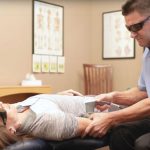Lower Body Injuries from Car Accidents
Northern Nevada Chiropractic has helped hundreds of people with their injuries from car accidents by restoring their spinal function back to normal after a car crash.
The average human head weighs between 10 and 12 pounds. As it gets whipped around in an auto collision, it is very easy to injure the supporting muscles of the neck and the ligaments that anchor the bones together and provide stability to the upper spine. Think of it like a bowling ball balancing on a broomstick. It helps you understand just how hard those muscles and ligaments have to work to keep our bowling ball heads balanced on our broomstick necks.
But in addition to the typical neck and back injuries, there are often lower extremity injuries from car accidents that accompany the common complaints of sprained necks and chest bruises caused by seat belts. Car accidents can damage these lower extremity joints due to factors or rapid changes in velocity, the laxity of the resting joints, and the hard dashboard surfaces that your body will strike in a collision.
Hip injuries in a car accident
The lower extremity joints of the hip, knee, and ankles are seemingly more simple and stable than the delicate neck, but this is not always the case. The hip joint for example is the most stable joint in the human body because it is highly resistant to dislocation. When the hip is flexed (such as when you are seated in your car) the back of the hip is vulnerable to sprain because the posterior ligaments are already tight. Any additional load the hips are forced to assume will be delivered to a tight ligament and the tight ligament is less capable of absorbing the shock. This is why our doctors perform hip examinations after auto accidents to test for these ligament injuries that are often overlooked for more life-threatening injuries in the emergency room.
Knee injuries and pain after a car crash
The knee is primarily a hinge joint that adds stability to the fully extended and the fully flexed knee. Injuries will likely occur when the knee is flexed partially (such as when you are seated in a car) and a load of shear force is applied to the knee. When sitting, the ligaments are not stabilizing the knee and it allows the tibia to glide underneath the femur and the meniscus can be cut internally.
Ankle injuries to look for after a car accident
The ankle joint has an inherent weak point known as the anterior talofibular ligament. If you ever roll your ankle and the toes go underneath your ankle you will likely suffer an inversion sprain. The relaxed position of the left foot against the floorboard of the car as we drive is one most people don’t consider. But if you happen to have a slight inward bend in your left foot as you rest it on your floorboard the sudden absorption of energy in an auto collision will cause inversion sprains depending on the severity of the collision.
With these potential injuries to the lower body, it makes sense why your legs are bothering you after a car accident.
Lower extremity ligament injuries are often masked by the muscle guarding immediately following a crash. The injury only shows up weeks after the auto accident when the muscles release and your range of motion is able to be challenged. If you are involved in an auto collision, you need to have your entire body comprehensively evaluated – not just your sorest spots!





